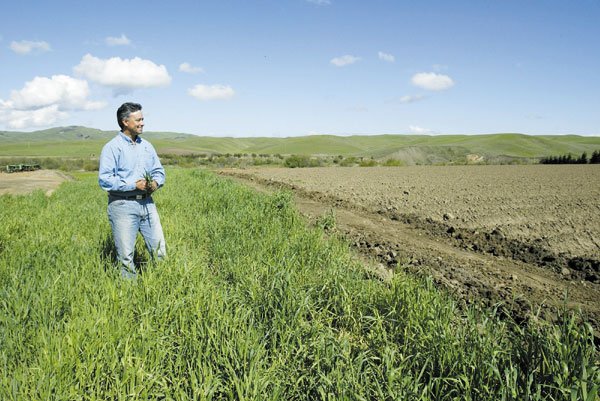Farmers are banding together to protect waterways and their
investments
When it pours and water rushes down the foothills, it carries silt and sludge into streams and takes farmers’ livelihoods down the drain.
“Water comes off the hills and hits the ditch about 100 miles an hour,” said Tim Chiala, of Morgan Hill’s George Chiala Farms. “Erosion isn’t any good for anyone. We don’t want our topsoil in the creek any more than environmentalists do.”
Runoff from farm operations can impede the flow of streams and creeks and damage ecosystems all the way to the ocean. And when water runs off a farm, it takes with it vital and expensive nutrients and pesticides. So it’s been easy to enlist farmers up and down South Valley to come together to ensure local waterways aren’t harmed by those who still consider this the Valley of the Heart’s Delight.
Growers in Santa Clara, San Benito, Santa Cruz, Monterey, San Mateo and San Luis Obispo counties have joined forces with a number of environmental agencies and created the Agricultural Water Quality Alliance to help growers meet new environmental regulations and protect investments that can be washed away by a good hard rain.
The alliance has been so successful that it was recently honored with the state’s highest environmental honor, The Governor’s Economic and Environmental Leadership Award. Nearly 80 percent of the farmland in Santa Clara and San Benito counties is now covered by a farm water management plan, and farmers young and old are learning new tricks.
Richard Silva, of Topflavor Farms in San Juan Bautista, has been using cover crops, which help water percolate in a field instead of running toward a low point, for 20 years. But lately he’s been planting grass on unpaved roads on his 800 acres of vegetable row crops, and lining his fields with rye grass to keep water on his farm and off county roads.
“What we’re trying to do is be more friendly with our neighbors,” Silva said. “Every ranch has its drainage areas. You have to be sensitive to where water might want to leave your property and how it affects your neighbor and his property.”
Many of the methods to control runoff from farms are as old as the hills. The most widely used are cover crops, the use of low-lying, often native grasses to help keep water where it falls. Rye grasses and mustard plants are especially effective and also improve soil quality.
David Vanni, who owns Solis Winery in Gilroy with his wife, Valerie, plants a red fescue among his vineyards and near Bod Fish creek, which runs along his property. The Vannis are fortunate to grow their grapes on porous turf, but still have to protect the creek from the worst downpours. The grasses are also home to ladybugs and wasps, which prey on crop-damaging aphids and spider mites.
“It has to rain pretty heavy, but we can get a little runoff in the creek,” Vanni said. “We planted the grass. It acts as a filter and prevents water from eroding the creek bank.”
Newer techniques, such a drip irrigation, which has been around for a while but has only recently grown into wide use, are taught at special classes that are the jumping-off point of the alliance. More than 300 South Valley farmers have attended a 15-hour short course to learn the latest techniques to prevent runoff and erosion.
Drip irrigation is a technology that delivers only the necessary amount of water, fertilizers and pesticides to crops and leaves very little to be washed away in a storm. Even farmers who already use the method learn a lot at the short course, said Mary Ellen Dick, an agricultural water expert who has coordinated many of the alliance programs.
“Many farmers have practices they know, but this is giving them more tools,” Dick said. “I’ve seen more and more farmers get involved. When I drive up Highway 101, I see all the vineyards with cover crops instead of bare dirt. In the rainy season, we’re not getting erosion.”
The alliance was born in 2000 as a way to combat sediment buildup in Monterey Bay, the ultimate destination for runoff from South Valley farms via the Uvas and Llagas watersheds and the Pajaro River. It was popular immediately, but participation took off in 2002 after the State Water Resources Control Board developed new water discharge requirements for farmers.
The regulations require farmers to apply for what’s known as a waiver for the right to discharge water and conduct monthly tests to demonstrate that their operations aren’t harming surface or groundwater. Some growers resent the regulations, in part because they feel they’re being singled out unfairly for the state’s environmental troubles, and in part because meeting the requirements is costly. A major grower could spend $25,000 a year to prove his farm is up to standards.
“It requires mounds of paperwork, and we have to pay a lot more money,” said Paul Hain, executive director of the San Benito County Farm Bureau. “Most farmers in our area are doing a pretty good job because when you have sediment draining off your fields, that’s your livelihood draining away.”
But, Hain added, “it is designed to make people more aware of our problems and by doing that, it improves water quality.”
And the alliance, with the blessing of the Central Coast Regional Water Quality Control Board, has eliminated many of the headaches and drastically lowered compliance costs.
To meet the new regulations, growers must submit to the control board a farm water management plan, which details how they will prevent runoff and sediment from fouling waterways, but they don’t have to conduct their own tests. Instead, growers in the alliance pay into a fund, based on the size of their operation, to finance tests conducted throughout the watershed.
Rather than field-by-field testing, the alliance pays for monitoring at critical places such as the mouth of the Pajaro and at the forks and intersections of major creeks and streams.
“By everyone combing, this gives us a lot of monitoring for a much smaller price per farmer,” Dick said. “If they find a spike in a pollutant, then they can pinpoint its location. The idea is, if you’ve signed up and are doing the things you need to do, you shouldn’t be having a problem.”
With the alliance, even larger growers like the Chialas, with 330 acres, pay a little less than $1,000 a year. Chiala still didn’t enjoy writing the check, nevertheless he’s out in front of changes in farm practices to protect the environment. Chiala Farms operates almost entirely with drip irrigation and had many of the practices it uses today in place before the alliance began.
“When it came time to fill out the waiver, we had it pretty much all in place,” he said. “We’re proactive. This has been a proactive thing where farmers and environmentalists worked together.”
Participation in the Agricultural Water Quality Alliance
Santa Clara County
Total number of farmers: 532
Number of farmers in the program: 158
Total Acreage: 57,977
Acreage covered in program: 33,592
Percentage of acreage in program 58
San Benito County
Total number of farmers: 335
Number of farmers in the program: 168
Total Acreage: 239,776
Acreage covered in program: 204,600
Percentage of acreage in program: 85













